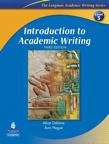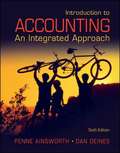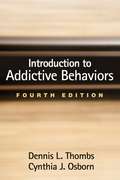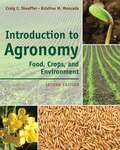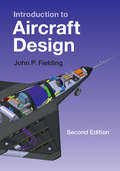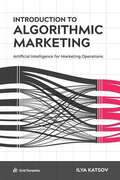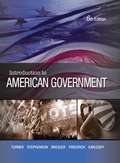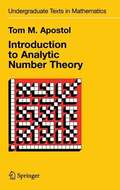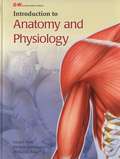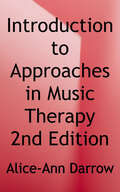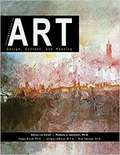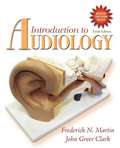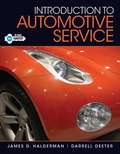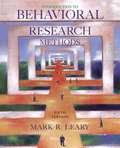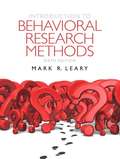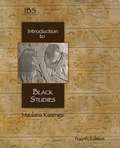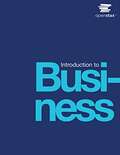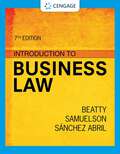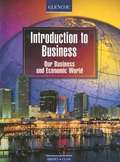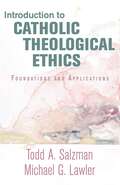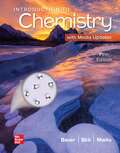- Table View
- List View
Introduction of Health Occupations: Today’s Health Care Worker (6th Edition)
by Shirley A. Badasch Doreen S. ChesebroProviding both basic core knowledge as well as an overview of many health care professions, Introduction to Health Occupations is an ideal resource for students preparing for entry-level health occupation positions.
Introduction to Academic Writing
by Ann Hogue Alice OshimaThe Third Edition of Introduction to Academic Writing, by Alice Oshima and Ann Hogue, continues in the tradition of helping students to master the standard organizational patterns of the paragraph and the basic concepts of essay writing. The text's time-proven approach integrates the study of rhetorical patterns and the writing process with extensive practice in sentence structure and mechanics. Features of the Third Edition: A step-by-step approach guides students seamlessly through the process of writing. Clear, succinct explanations help students to understand and apply key concepts and rules. Numerous models and varied practice support students at all stages of writing. NEW instruction and practice in summary writing prepare students for academic work. NEW Try It Out! exercises give students opportunities to assess mastery of skills. NEWself-editing and peer-editing worksheets motivate students to revise their work. Introduction to Academic Writing is also available with CriterionSM Publisher's Version, which provides instant online feedback on student writing: Students simply submit their writing online and instantly receive personalized feedback on: Grammar, Usage, Style, Mechanics, Organization, and Development (essays only). Students can turn in better writing, and teachers can save time spent correcting drafts. Clickon the "Resources" link to order the edition with CriterionSM Publisher's Version The Longman Academic Writing Series consists of: Level 1 Fundamentals of Academic Writing Level 2 First Steps in Academic Writing, Second Edition Level 4 Writing Academic English, Fourth Edition.
Introduction to Accounting: An Integrated Approach (6th Edition)
by Penne Ainsworth Dan DeinesThe text incorporates real world applications, including actual financial statements, to reinforce the relevance of topics to real business situations and promote student interest. The text also promotes active learning through Enhance Your Understanding probing questions placed sporadically throughout many chapters, Of Interest boxes that provide additional information relating to the chapter concepts, new Fast Fact boxes that provide additional information related to chapter concepts in a short, trivia-like manner, and end-of-chapter group exercises.
Introduction to Addictive Behaviors (4th Edition)
by Dennis L. Thombs Cynthia J. OsbornThis widely adopted text introduces students and practitioners to major contemporary models of addiction. Assuming no prior knowledge in the field, the book shows how theory and research can offer a roadmap for effective intervention. It presents multiple perspectives on the causes and mechanisms of substance use problems, reviews their strengths and limitations, and examines their implications for helping people change their behavior. Evidence-based treatment and prevention strategies are described.Pedagogical Features Include:*Accessible style and clear organization.*Concise end-of-chapter summaries.*Review questions in every chapter.New to This Edition*The latest research on prevention and treatment, including current data and revised discussions of genetic influences, family treatment models, and many other topics.*Updated for DSM-5.*Chapter on behavioral addictions.*Chapter on promoting motivation and autonomy.*Chapter on evidence-based practice.
Introduction to Agronomy: Food, Crops, and Environment
by Craig C. Sheaffer Kristine M. MoncadaNIMAC-sourced textbook
Introduction to Aircraft Design (Cambridge Aerospace Series)
by Fielding John P.The new edition of this popular textbook provides a modern, accessible introduction to the whole process of aircraft design from requirements to conceptual design, manufacture and in-service issues. Highly illustrated descriptions of the full spectrum of aircraft types, their aerodynamics, structures and systems, allow students to appreciate good and poor design and understand how to improve their own designs. Cost data is considerably updated, many new images have been added and new sections are included on the emerging fields of Uninhabited Aerial Vehicles and environmentally-friendly airlines. Examples from real aircraft projects are presented throughout, demonstrating to students the applications of the theory. Three appendices and a bibliography provide a wealth of information, much not published elsewhere, including simple aerodynamic formulae, an introduction to airworthiness and environmental requirements, aircraft, engine and equipment data, and a case study of the conceptual design of a large airliner. Cost data is considerably updated, many new images have been added, and new sections are included on the emerging fields of uninhabited aerial vehicles and environmentally friendly airlines Three appendices and a bibliography provide a wealth of information and data, much not published elsewhere, providing students and practitioners with the essential information they need to help them do their jobs Examples from real aircraft projects are presented throughout and an appendix includes a case study of the conceptual design of a large airliner, demonstrating to students the applications of the theory
Introduction to Algorithmic Marketing: Artificial Intelligence for Marketing Operations
by Ilya KatsovIntroduction to Algorithmic Marketing is a comprehensive guide to advanced marketing automation for marketing strategists, data scientists, product managers, and software engineers. It summarizes various techniques tested by major technology, advertising, and retail companies, and it glues these methods together with economic theory and machine learning. The book covers the main areas of marketing that require programmatic micro-decisioning - targeted promotions and advertisements, eCommerce search, recommendations, pricing, and assortment optimization.
Introduction to American Government
by Charles C. Turner Robert J. Bresler Robert J. Friedrich D. Grier Stephenson Jr.The need persists for widespread mastery of the political system John Quincy Adams once described as "the most complicated on the face of the globe." Adams was writing about two hundred years ago, and things certainly haven't gotten less complicated since then. In the early 2000s we experienced a number of political complications, including three close and contentious presidential elections that geographically and ideological divided our nation into "red" and "blue" states.
Introduction to Analytic Number Theory (Undergraduate Texts in Mathematics)
by Tom ApostolThis book is the first volume of a two-volume textbook for undergraduates and is indeed the crystallization of a course offered by the author at the California Institute of Technology to undergraduates without any previous knowledge of number theory.
Introduction to Anatomy and Physiology
by Susan J. Hall Michelle A. Provost-Craig William C. RoseNIMAC-sourced textbook
Introduction to Approaches in Music Thearpy
by Alice-Ann DarrowThe intent of all approaches is to stimulate positive changes in clients through music, although some approaches emphasize changes in specific areas of human functioning: cognitive, physical, psychological, or social. <p><p>All of the approaches depend on the appeal and influence of music to bring about changes in clients, all of the approaches provide valid avenues for the therapeutic work, and all of the approaches require training to be used effectively. The differences in approaches are suited to the diversity of practicing clinicians and the clients they serve. <p><p>The book is organized into three major sections: Approaches Adapted from Music Education, Psychotherapeutic Approaches to Music Therapy, and Medical Approaches to Music Therapy. The organization of the chapters is similar. Chapters begin with an overview of a specific approach to music therapy. Also included in each chapter is the history or background of the approach, description of the approach including philosophical orientation, clinical applications of the approach, related research, summary or conclusions, and suggestions for further reading. <p><p>Written for entering undergraduate or graduate students in music therapy, Introduction to Approaches in Music Therapy, presents the major approaches to music therapy used today.
Introduction to Art: Design, Context, and Meaning
by Pamela J. SachantIntroduction to Art: Design, Context, and Meaning offers a comprehensive introduction to the world of Art. Authored by four USG faculty members with advance degrees in the arts, this textbooks offers up-to-date original scholarship. It includes over 400 high-quality images illustrating the history of art, its technical applications, and its many uses. Combining the best elements of both a traditional textbook and a reader, it introduces such issues in art as its meaning and purpose; its meaning and purpose; its structure, material, and form; and its diverse effects on our lives. Its digital nature allows students to follow links to applicable sources and videos, expanding the students’ educational experiences beyond the textbook. Introduction to Art: Design, Context, and Meaning provides a new and free alternative to traditional textbooks, making it an invaluable resource in our modern age of technology and advancement.
Introduction to Audiology (10th edition)
by Frederick N. Martin John Greer ClarkThe ninth edition of Martin's (U. of Texas at Austin) and Clark's (U. of Cincinnati) textbook features updated material throughout the text, including more detailed discussions of recent objective measures; new material on licensing/certification, outcome measures, and evidence-based practice; a revised discussion of the rapidly evolving measures of auditory evoked potentials; and separate discussions of pediatric and adult hearing aid selection/verification and hearing loss management.
Introduction to Automotive Service
by James D. Halderman Omar D. Trinidad Darrell DeeterIntroduction to Automotive Service covers all eight areas of automotive service, plus the soft skills and tool knowledge that you must know when seeking entry-level employment. The text presents all systems together, making it easier for you to see how automotive systems are intertwined and connected. The text's 40 short chapters divide the content into individual topics to make it easier for you to learn and master the material. Offering a solid foundation in the basics, this text uniquely addresses simple inspection and service procedures without being overwhelming.
Introduction to Bayesian Econometrics: Second Edition
by Edward GreenbergThis textbook explains the basic ideas of subjective probability and shows how subjective probabilities must obey the usual rules of probability to ensure coherency. It defines the likelihood function, prior distributions and posterior distributions. It explains how posterior distributions are the basis for inference and explores their basic properties. Various methods of specifying prior distributions are considered, with special emphasis on subject-matter considerations and exchange ability. The regression model is examined to show how analytical methods may fail in the derivation of marginal posterior distributions. The remainder of the book is concerned with applications of the theory to important models that are used in economics, political science, biostatistics and other applied fields. New to the second edition is a chapter on semiparametric regression and new sections on the ordinal probit, item response, factor analysis, ARCH-GARCH and stochastic volatility models. The new edition also emphasizes the R programming language.
Introduction to Behavioral Research Methods (5th edition)
by Mark R. LearyA textbook for the research methods course that integrates the various topics covered by using the concept of variability as a unifying theme. Among the changes in this revised edition are the addition of a second chapter that focuses on measurement and a new chapter on advanced correlational research strategies. Annotation c. by Book News, Inc. , Portland, Or.
Introduction to Behavioral Research Methods (6th Edition)
by Mark R. LearyIntroduction to Behavioral Research Methods incorporates the four basic approaches to behavioral research (descriptive research, correlational research, experimental research, and quasi-experimental research), and shows students how to conceptualize questions, measure variables, design studies, and analyze data. Chapters on research ethics and scientific writing (including the most recent version of APA style) round out the book. Throughout each chapter, boxes on "Developing Your Research Skills" and "Behavioral Research Case Study" provide practical examples and pique student interest. Teaching & Learning Experience Personalize Learning - MySearchLab delivers proven results in helping students succeed, provides engaging experiences that personalize learning, and comes from a trusted partner with educational expertise and a deep commitment to helping students and instructors achieve their goals. Improve Critical Thinking -- New up-to-date Behavioral Research Case Studies help students apply research to practice. Engage Students -- The text is designed to make research methods understandable, useful, and interesting for students. Explore Research -- Real research, tidbits about the lives of famous researchers, and intriguing controversies that have arisen in behavioral science are included. A lab manual in MySearchLab helps engage students in the research process. Support Instructors -- MyTest, PowerPoints, and an instructor's manual offer additional support for instructors. Note: MySearchLab with eText does not come automatically packaged with this text. To purchase MySearchLab with eText, please visit: www.mysearchlab.com or you can purchase a valuepack of the text + MySearchLab with eText (at no additional cost). VP: 0205196284 / 9780205196289
Introduction to Black Studies (4th Edition)
by Maulana KarengaA comprehensive textbook that covers Black/African American studies across a variety of academic disciplines.
Introduction to Business
by Amit Shah Lawrence J. Gitman Carl McDaniel Monique Reece Linda Koffel Bethann Talsma James C. HyattIntroduction to Business covers the scope and sequence of most introductory business courses. The book provides detailed explanations in the context of core themes such as customer satisfaction, ethics, entrepreneurship, global business, and managing change. <p><p>Introduction to Business includes hundreds of current business examples from a range of industries and geographic locations, which feature a variety of individuals. The outcome is a balanced approach to the theory and application of business concepts, with attention to the knowledge and skills necessary for student success in this course and beyond. This kindle edition is best viewed in single column format.
Introduction to Business Law
by Jeffrey F. Beatty Susan S. Samuelson Patricia Sánchez AbrilDiscover the business law text you'll enjoy reading with Beatty/Samuelson/Abril's INTRODUCTION TO BUSINESS LAW, 7E. Students like you explain that this is the best text they have ever read and they had no idea law could be so interesting. This book uses conversational writing to explain complex topics and emerging legal trends in easy-to-understand language. With 75 years of combined teaching experience, these award-winning authors know how to clearly explain topics and keep your interest. Because the authors actually practiced law before they became teachers, they also describe how theories of law work in everyday business practice. This edition is packed with current examples and real-life scenarios relevant to daily life - from marijuana contracts and the research behind executive compensation to the impact of Covid-19 and #MeToo in the workplace. MindTap and Infuse digital resources help clarify concepts with interactive cases and learning tools.
Introduction to Business: Our Business and Economic World
by Betty J. Brown John E. Clow Mcgraw-Hill StaffFrom entrepreneurship to the global economy, Introduction to Business introduces your students to the ever-changing world of business and economics. It's up-to-date, full of high interest features, and designed to help your students explore business opportunities while learning to make their own informed economic decisions.
Introduction to Catholic Theological Ethics: Foundations and Applications
by Todd A. Salzman Michael G. LawlerTwo renowned, award-winning authors in the field of virtue and sexual ethics introduce and then apply their ethical method to such topics as relativism, ecology, bioethics, sexual ethics, and liberation theology. The result is a foundational text for undergraduate courses in Catholic theological ethics.
Introduction to Catholicism: A Complete Course
by James SociasThis first book of the Didache Series explains what it means to be Catholic. The book presents Church Prayer Holiness The Trinity The Blessed Virgin Mary Sacred Scripture The Ten Commandments The Sacraments and more The Didache Series presents the life and doctrine of the Roman Catholic Church in the context of the Catechism of the Catholic Church and the teachings of Vatican II. The series draws from the Catechism of the Catholic Church, Sacred Scripture, the lives of the saints, the Fathers of the Church, and the teachings of Vatican II as witnessed by the pontificate of Pope John Paul II. This series is designed for high school and adult education, seminaries and colleges, RCIA, catechism classes, and home schooling.
Introduction to Catholicism: A Complete Course (2nd Edition)
by James SociasIntroduction to Catholicism, 2nd Edition, contains the same Catholic teaching found in the popular original textbook, with expanded topics. Based on the Catechism of the Catholic Church, this text covers the basic tenets of the Faith and what it means to be Catholic; to include an additional 200+ pages, a new design layout, and additional pieces of full-color liturgical art. Topics include: The Holy Catholic Church The Blessed Trinity The Paschal Mystery The Blessed Virgin Mary The Sacraments and Prayer Christian Morality and the Universal Call to Holiness New chapter on Social Doctrine This textbook is published with ecclesiastical approval from the Archdiocese of Chicago.
Introduction to Chemistry
by Rich Bauer James Birk Pamela MarksThe fifth edition of Introduction to Chemistry continues to build on the belief that students learn best when the text and our classroom presentations focus on a conceptual approach to chemistry. <p><p>This book is grounded in educational research findings that address topic sequence, context, conceptual emphasis, and concept embedded numerical problem solving. Throughout the text, content is related to students’ daily lives and shows them how chemistry allows us to understand the phenomena—both simple and complex— that we encounter on a regular basis. This text presents macroscopic chemical phenomena early and uses familiar contexts to develop microscopic explanations. <p><p>Introduction to Chemistry is designed for the freshman-level Introductory Chemistry course that does not have a chemistry prerequisite and is suitable for either a one-semester course or a two-semester sequence. The book targets introductory courses taken by non-physical science majors who may be in allied health, agriculture, or other disciplines those that do not require the rigor of a science major’s General Chemistry course, or for students fulfilling university liberal arts requirements for science credits. In addition, students who lack a strong high school science background often take the course as a preparation for the regular general chemistry sequence.

